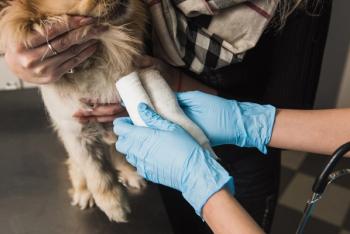
Medical management of respiratory distress following trauma (Proceedings)
Initial triage evaluation of the post-trauma patient should include a careful evaluation of respiratory function.
Initial triage evaluation of the post-trauma patient should include a careful evaluation of respiratory function. The patient is evaluated with particular emphasis on three major aspects of the respiratory system:
1) Is there a patent airway, or could it be obstructed by external compression, tracheal tears, foreign bodies or blood clots?
2) Is there normal mechanical function of the chest wall and pleural cavity, or could respiratory failure be caused by the presence of air, blood or abdominal contents (diaphragmatic hernia) in the pleural space; or a failure of effective motion of the chest wall due to the presence of a flail chest or a high cervical spinal cord lesion?
3) Is a failure of oxygenation occurring due to pulmonary parenchymal lesions such as pulmonary contusions, atelectasis, or aspiration pneumonia?
If the airway is not patent, immediate steps are required to establish a functional airway. Such steps might include (but are not limited to) endotracheal intubation and suctioning, emergency tracheostomy, or foreign body removal. Similarly, if there is an abnormality in the chest wall or pleural cavity, aggressive steps such as thoracocentesis or surgery for a diaphragmatic hernia may be required. In either of these situations, definitive therapy is usually accompanied by oxygen supplementation. It is important to remember that many trauma patients suffer from multiple possible causes of respiratory distress. For example, pneumothorax is commonly accompanied by pulmonary contusions.
The most common causes of respiratory distress following trauma in dogs are pneumothorax and pulmonary contusions.
Pneumothorax
Pneumothorax is a common complication of trauma, and is the most likely cause of dyspnea in such animals. It is most commonly caused by rupture of alveoli secondary to increase in intrathoracic pressure against a closed glottis. Less frequently, pneumothorax can also be caused by direct penetration of the thoracic wall by a sharp object, rib fractures, or rupture of major airways such as the trachea or bronchi. If a major airway has ruptured, pneumothorax will be accompanied or preceded by pneumomediastinum. The absence of pneumomediastinum on thoracic radiographs makes a tear in a major airway very unlikely.
When the trauma patient is presented in severe respiratory distress, diagnostic tests such as radiographs may be impossible to obtain, or may cause the unstable animal to decompensate. In such animals, the clinician must rely on a physical examination diagnosis of pneumothorax. Physical examination abnormalities that may be found in the animal with pneumothorax include:
- tachypnea: rapid, shallow breathing
- recruitment of the secondary muscles of respiration
- nasal flare
- unwillingness to lie down, especially in lateral recumbency
- inward scalloping of the intercostal muscles on inspiration
- barrel chest
- muffled or quiet lung sounds, difficulty ausculting the heart
- may be unilateral
- percussion of the thorax may reveal excessive resonance suggestive of pneumothorax
If radiographs can be obtained, the classical signs of pneumothorax may be seen:
- elevation of the cardiac silhouette off the sternum
- collapse of the lung lobes, especially the caudal lobes
- absence of lung markings in the periphery
- pneumomediastinum may be diagnosed if the great vessels in the cranial mediastinum are outlined by air
If pneumothorax is suspected based on physical examination, diagnostic thoracocentesis should be performed immediately, and the pleural space evacuated until negative pressure is obtained. Radiographs should not be obtained prior to performing thoracocentesis, because the stress of positioning and restraint may precipitate decompensation. Furthermore, radiographs will have to be obtained after evacuation of air from the pleural space (to assess the severity of concurrent pulmonary contusions and to rule out diaphragmatic hernia), and therefore obtaining images prior to thoracocentesis will result in additional and unnecessary charges to the client.
Thoracocentesis may be repeated as often as necessary. In many cases, a single procedure is required. Some dogs or cats, however, may require multiple aspirations of air from the chest if an ongoing leak occurs. If large volumes of air are aspirated on multiple occasions, or if repeated thoracocentesis necessary, the clinician may choose to place a chest tube for intermittent aspiration or continuous negative pressure suction. Surgical aspects of chest tube placement are beyond the scope of this presentation. Supplementation of oxygen is recommended whenever a stressful procedure such as thoracocentesis or chest tube placement is undertaken. In near cardiac arrest cases, if a tension pneumothorax is suspected, the animal should be intubated and a mini thoracotomy should be performed immediately to allow evacuation of the pleural cavity. In such cases, regular thoracocentesis with syringe and stopcock will probably be too slow to be effective.
Pulmonary contusions and flail chest
Pulmonary contusions consist of hemorrhage in the lung parenchyma caused by tearing and crushing during direct trauma to the thorax. Relatively small volumes of blood in the lung may significantly compromise lung function by causing ventilation-perfusion mismatch. Animals with coagulopathies such as Von Willebrands disease may have increased risk of pulmonary hemorrhage as a result of trauma. Following fluid resuscitation and capillary damage in the shock patient, the hemorrhage may later be accompanied by pulmonary edema. Most animals with pulmonary contusions, therefore, show deterioration of respiratory function during the initial 12-24 hours following trauma, and then gradually improve. In general, marked clinical improvement in respiratory status occurs within 48 hours, with a more gradual resolution of radiographic lesions.
A flail chest is a segment of one or more ribs that are fractured in 2 places, and therefore are able to move independently of the rest of the chest wall. Such an injury is commonly associated with significant underlying pulmonary contusions. Respiratory distress accompanying flail chest is primarily attributable to pain and the accompanying pulmonary contusions, rather than to the unstable thoracic wall. Current recommendations for management therefore focus primarily on pain control and treatment of contusions, rather than on stabilization of the flail segment.
Diagnosis of pulmonary contusions
- historical findings consistent with blunt trauma
- tachypnea, increased respiratory effort, cyanosis
- auscultation of harsh bronchovesicular sounds or crackles
- expectoration of blood or blood-tinged fluid
- thoracic radiographs should always be performed to rule out hemothorax, pneumothorax, or diaphragmatic hernia. If pulmonary contusions are present, there are usually patchy areas of alveolar pattern, which may be focal or asymmetrical.
Just as bruising in other areas of the body must resolve on its own, there is no medical treatment that will cause resolution of pulmonary contusions. Management of such patients is therefore based primarily on supportive care, and treatment of other traumatic injuries. Oxygen supplementation should be considered if hypoxia is present. The most severely affected animals may require intubation and positive pressure ventilation, especially as their pulmonary dysfunction worsens over the initial 24 hours. In the shock patient, fluid therapy may be required to support cardiovascular function. If possible, fluid therapy should be conservative, since it may lead to deterioration of pulmonary function by exacerbating pulmonary edema.
The most important consideration in fluid resuscitation of an animal with pulmonary contusion is the potential for increased hemorrhage and thus worsening the respiratory compromise. Improvement in blood pressure with administration of crystalloids and colloids results in increased capillary hydrostatic pressure, and potentially exacerbates fluid movement into the interstitium of the lung. Colloids and/or hypertonic saline can potentially move into the area of hemorrhage, and due to the increased oncotic or osmotic pressure, pull water along with them. In fact, in any patient that has suffered pulmonary hemorrhage, some degree of concurrent pulmonary edema is expected following fluid resuscitation.
In patients with pulmonary contusions, colloids could be considered advantageous because a lesser volume is required for shock resuscitation compared to crystalloids. Crystalloids may have a greater tendency to distribute into the interstitial space, which can worsen pulmonary edema and hemorrhage if the pulmonary lymphatic system is unable to keep up with the volumes produced. In patients with increased microvascular permeability, colloids may also be a better fluid choice because of their large molecular mass. In severe pulmonary capillary leak syndromes, however, colloids may also leak into the interstitium, potentially causing more harm than good. The clinician must use good clinical judgment in deciding whether crystalloids or colloids are appropriate for individual patients with pulmonary contusions. If in doubt, and the patient has significantly low TS, a small test dose of colloid can be administered, and the patient carefully observed for response to therapy. If there is a deterioration in the respiratory status of the patient following the test dose, further administration of colloids should be avoided.
When patients in respiratory distress are also exhibiting signs of shock, the determination of the total volume of fluids required for resuscitation can be very challenging. The clinician is attempting to walk a fine line between improvement of tissue perfusion and worsening of the pulmonary status. When pulmonary contusions are present, increments of 10-20% of the shock bolus of crystalloids or colloids should be administered, while continually assessing pulmonary function. Serial measurements of urine output, urinalysis, arterial blood pressure, arterial lactate concentrations, and arterial blood gases will help decide which way the balance is leaning.
Despite judicious use of fluid therapy, in the most severely affected patients pulmonary hemorrhage can continue, interstitial edema fluid can accumulate, and pulmonary function can deteriorate. Following fluid therapy in some of these patients, once adequate intravascular volume expansion has been achieved, small doses of diuretics (furosemide 0.5-1 mg/kg, or 0.1-0.3 mg/kg/hr CRI) may help to resolve the pulmonary edema component of the respiratory compromise. Diuretics should not be expected to remove erythrocytes from the lung parenchyma and since the primary mechanism of action of diuretics is to decrease the intravascular volume by inducing diuresis, there is no rationale for diuretic use immediately after presentation. By causing diuresis, diuretics decrease the intravascular volume, which is contraindicated in the shock patient.
The most severely affected animals may require intubation and positive pressure ventilation, especially as their pulmonary dysfunction worsens over the initial 24 hours. If the PaO2 remains less than 60mmHg, or the PaCO2 remains greater than 50 mmHg, despite oxygen supplementation with an FiO2 of 60% or greater, then mechanical ventilation should be considered as a means of supporting the patient until the pulmonary contusions resolve.
Diuretics such as furosemide (0.5-2 mg/kg IV or IM) can be administered after several hours, when hemorrhage is accompanied by edema and if respiratory distress is severe.
The most common complication is the development of bacterial pneumonia, due to systemic immunosuppression, reduced pulmonary defenses, and aspiration of gastrointestinal tract contents. Development of a moist productive cough, and failure to improve within 48 hours, should provoke suspicion of pneumonia. Less commonly, animals with severe shock may develop Acute Respiratory Distress Syndrome.
References available on request
Newsletter
From exam room tips to practice management insights, get trusted veterinary news delivered straight to your inbox—subscribe to dvm360.





